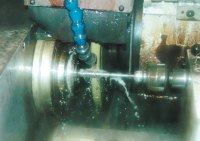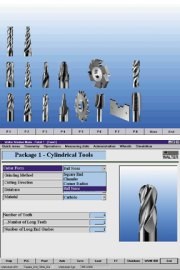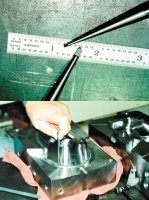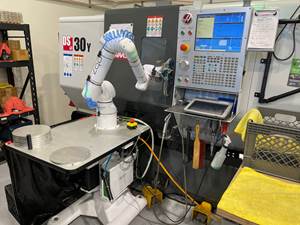The Right Tool, Right Away
In-house custom tool grinding extends the reach of CNC machining.
CNC machining centers go further today than ever before. Thanks to improved performance and precision, they carry many jobs nearly to completion that would have required extensive handwork not long ago. But it may take more than just the right machine to let CNC machining go this extra distance. It may also take the right cutting tool—and that may mean a tool geometry that's not represented in any tool supplier's standard catalog. When this is the case, the most efficient way to obtain this tool may be to grind it in-house, using a grinder that sits on the same shop floor as the machining center.
The practice seems to be growing more common in die and mold shops, for example. Some machining centers today are precise and fast enough that hardened die and mold tooling can be finished at the machining center effectively, using fast, light milling cuts as an alternative to EDM. However, this approach may require the machining center to cut intricate details that the complex geometry of the workpiece makes difficult to reach. And because of the single-piece nature of die and mold work, such a shop may never face exactly the same tool accessibility challenge twice. So for one mold shop that regularly finish-mills hardened workpieces, the solution is to use an in-house manual grinder to create simple custom carbide tooling for the difficult cuts on an as-needed basis. (See photos.)
A more sophisticated example of a shop that relies on in-house custom tooling is Metalex Manufacturing of Cincinnati, Ohio. Among the specialties of this 120-employee company is milling solid-body impellers for space flight engines. The company says it has machined 90 percent of the impellers currently being used in NASA space shuttles. Parts like these pose still greater accessibility challenges. An impeller is a wheel with curving internal blades—"vanes"—radiating out from the hub. Because these vanes define the part's internal structure, machining an impeller means sending long tools deep into curving tunnels.
Metalex is committed to using CNC machining for all metal removal on these parts. Where other shops have used extensive hand finishing, Metalex uses handwork only to polish. The shop relies on horizontal machining centers that achieve five-axis machining using a combination rotary table configuration. This configuration provides for a large rotary-axis range of motion. However, even this is not enough to let standard end mills reach many of the surfaces in need of machining. For these surfaces, only the combination of five axes plus custom tooling will do.
The shop has its own CNC cutter grinders. It owns three of these machines. The shop uses them (in addition to some manual cutter grinders) to machine its own house-designed carbide end mill geometries. For example, it machines tools with tapered cutting forms to mill sloping surfaces within the part. The shop also machines tools with shallower flutes and/or thicker webs than conventional designs, for improved rigidity in titanium milling. In addition, the shop often uses the grinders simply to machine conventional end mill forms on the ends of tools that are longer and more slender than what tool suppliers typically provide.
However, even these cutter grinders don't machine all of the custom tooling. Some of the shop's most critical custom tools are instead machined on a CNC OD grinder. These carbide tools are long-reach end mills for which the customization is not in the cutter form, it's in the shank. Equipping these tools with ground-in relief lets a ball-shaped cutter—actually a burr form—take light cuts from the far sides of curved surfaces. The effect is like machining beyond the horizon. (See left.)
In fact, this particular use of custom tools helped Metalex win the NASA impeller work in the first place. Before Metalex, shops machining these parts used handwork to remove the material that was hardest to reach, particularly on the far sides of curves. But by engineering the cutting tools that allowed this same material to be removed through CNC machining, Metalex was able to remove the metal more consistently from vane to vane. Impeller balance improved by a factor of 10, the shop says. Thus, custom tools helped improve the very performance of the engine.
Metalex is a company invested heavily in the use of in-house custom tooling. As such, this shop's example will be useful to a shop considering a similar break—even if on a much smaller scale—away from using only standard tools. One thing Metalex shows is that incorporating the design and manufacture of custom tooling into the overall process does not have to add a great deal of complexity. In fact, mentioning this shop in the same context as a mold shop is useful, because mold shops have been dealing with similar concerns for years. Mold shops often use ram EDM—that is, EDM requiring a milled electrode. Where this is true, Metalex and a mold shop share much in common. In either shop, the process for the tool is engineered in parallel with the process for the part...and the tooling must be machined before the part can be.
In Metalex's case, the tooling is a solid-body end mill. And as for how custom this custom tooling needs to be, that decision is made while the job is being programmed.
House Tooling
Konrad Strecker, Jr., is a programmer for Metalex. He says he tries to use custom cutting tools only where they are essential. "My goal is to use standard tools for as much of the part as I can, and resort to customs only when I have to." Even so, out of 60 or so end mills chosen for a given impeller job, as many as 20 of those may be tools designed in-house.
Some custom tools are used so frequently, the shop thinks of them as if they were standards. The shop continually grinds more of these tools. Most are the long, relieved burr mills. But if an effective tool can not be found among either sort of standard tooling—standard for the world, or standard for Metalex—then Mr. Strecker or another programmer sets about designing a new custom tool for the job.
To locate interferences within the workpiece, and to experiment with custom tools designed to avoid these interferences, the shop uses stand-alone verification software. This software is particularly important for the burr tools, Mr. Strecker says. For the complex diameter profiles of these tools, the verification functionality built into the shop's CAD/CAM system is too limited. The CAM software allows a tool to be defined only as the combination of no more than three diameters. However, a customized burr tool with a series of reliefs and tapers may offer many more diameters than this. The verification software, by contrast, can model any of the shop's burr tool designs all the way back to the holder. The shop purchased this software from CGTech (Irvine, California).
When designing one of the relieved burr tools, the challenge to the programmer is to strike a compromise between access and rigidity. These tools reach deep into the workpiece. The tools are long and slender, even before grinding. Therefore, the programmer tries to design any tool so it has just enough relief to afford the necessary clearance, while leaving material in place to preserve as much tool rigidity as possible. The result can be a profile consisting of a series of stair-step diameter changes married by multiple tapers. And even at that, the next challenge is to find a milling cut light enough and stable enough that such a tool will not deflect unpredictably during machining. Accordingly, each custom tool that has passed verification is next proven in test cuts on the shop floor.
The burr geometry and the slender shank of the tool both enforce light depths of cut. However, chatter is also a consideration. And to minimize chatter, operators fine-tune speed, feed rate, and depth of cut together during the test cut process until some stable combination is found.
Many factors influence these parameters, notably the workpiece material. Aluminum is not necessarily easier to machine than titanium. The shop is learning this now, on an unusual job for impellers made of aluminum. Compared to titanium, this springier material can bring about more severe chatter problems when milled with the long, slender tooling. So the shop is in the process of relearning some of what it knows about effective cutting with these tools.
Custom Manufacture
Jim Stirneman leads the shop's cutter grinding area. He describes the process by which the custom burr tools are manufactured. It involves two setups at the OD grinder. This multi-step process lets the shop apply some batch production efficiencies to tooling that would otherwise be called for only in quantities of two or three at a time.
The CNC OD grinder does more than just tooling work. It can also grind production parts, up to a maximum diameter of 10.8 inches. The shop bought this machine from Spanish builder GER through SWH Grinding (Hauppauge, New York), its U.S. representative
In the first setup on this machine, the shop grinds two diameters into a carbide rod. At the head of the tool is the larger diameter, which will become the cutter form. This sits like a marshmallow at the end of the smaller-diameter region, which represents the most slender part of the shank. This connects to the stock left unmachined for now, and into which reliefs and tapers will be added later. Once the initial two diameters are in place, the shop sends the tool out in batches to have the burr geometry added.
"We could grind the burr forms ourselves. We would just have to add that geometry to our cutter grinder CNCs," Mr. Stirneman says. However, because the shop is able to request at least this custom grinding in batch quantities, using an outside contractor is still cost-effective.
When the straight shank and burr geometry have been machined, the tool then becomes a blank from which finished tools are machined, essentially as they are needed. This involves a second setup at the OD grinder. There, the blank tool is given the particular combination of relief and taper that is "custom" about that custom tool.
Cutter Grinders
Other tools are custom in their cutting geometry. Or, they add a conventional cutting form to a non-traditional body. Metalex grinds most of these custom tools using its three CNC cutter grinders. These machines came from Walter Grinders (Fredericksburg, Virginia).
Each of these machines resembles a small five-axis machining center, but with a grinding head in place of a metalcutting tool. The machine's workpiece is the cutting tool, and the workholding is a standard machining center toolholder. In fact, to make cutting tool runout as small as possible, the tool can be ground in the same toolholder that will hold it when the tool cuts. Tool and toolholder together can be sent as one unit from grinder to machining center.
Programming requires no G-codes. Instead, programming is a feature-based exercise performed at the control. To begin, the operator selects the tool he has in mind from among a variety of generic cutter types. For each of these types, the control has already been equipped with the necessary "tool paths." All that remains is to define the offsets. The operator does this by entering a variety of geometric parameters that define the specific tool to be ground. The operator also tells the control whether the cycle is an original grind or a regrind. Then, when the cycle starts, the control uses a touch probe to locate the workpiece—either a blank rod or a used tool—and define the material to be removed.
The majority of CNC cutter grinders are sold to cutting tool manufacturers and regrinders independent of any shop. However, according to the manufacturer of Metalex's machines, about 30 percent of its North American sales go to metalworking facilities having their own in-house cutter grinding areas. Large manufacturers often purchase these machines for regrinding, while a smaller shop like Metalex is more likely to purchase the machine because it has some ongoing need for custom tooling that an outside supplier can't fill effectively. According to one Walter Grinders representative, two questions determine whether any machine shop can justify its own CNC cutter grinder. They are:
1. Do we use enough custom tooling?
2. How happy are we with the tooling—either new or reground—that we get from outside?
Side benefits can come from having these machines in-house. Metalex bought its machines to make custom tools, but it also uses them to perform its own regrinds. In fact, regrinding accounts for most of the work the machines do.
One more side benefit has come not solely as a result of CNC cutter grinding, but instead as a result of the shop's reliance on custom tools. Metalex has recently entered into an unusually close relationship with one of its impeller customers. The customer has invited the shop not only to influence how a new impeller model is manufactured, but also to participate in the design process. From the very early stages of the design, Metalex has studied the part with an eye toward identifying features that will be difficult to machine, and discovering where the part's manufacturing cost can be significantly reduced just by making small geometry changes.
Metalex is perhaps the ideal consultant for this work. The shop knows what challenges can be solved by applying creative tooling, and how much cost is associated with each complex feature that demands a custom tool. Based on long experience with inventing the tooling that lets a machining center reach deeper into the workpiece, this shop understands just how far CNC machining can go.
Related Content
Becoming a More Efficient Shop With the Right Processes and Software
After refining its machining processes for more efficient production, this shop still needed a better way to track its data. Here's how it found a software solution.
Read MoreHow to Grow the Business with Real-Time Job Status Data
ERP systems that focus on making data more accessible can improve communication within a shop, reducing wasteful errors and improving capacity.
Read MoreWhen Handing Down the Family Machine Shop is as Complex as a Swiss-Turned Part
The transition into Swiss-type machining at Deking Screw Products required more than just a shift in production operations. It required a new mindset and a new way of running the family-owned business. Hardest of all, it required that one generation let go, and allow a new one to step in.
Read MoreCan Connecting ERP to Machine Tool Monitoring Address the Workforce Challenge?
It can if RFID tags are added. Here is how this startup sees a local Internet of Things aiding CNC machine shops.
Read MoreRead Next
3 Mistakes That Cause CNC Programs to Fail
Despite enhancements to manufacturing technology, there are still issues today that can cause programs to fail. These failures can cause lost time, scrapped parts, damaged machines and even injured operators.
Read MoreThe Cut Scene: The Finer Details of Large-Format Machining
Small details and features can have an outsized impact on large parts, such as Barbco’s collapsible utility drill head.
Read More.jpg;maxWidth=970;quality=90)
.jpg;width=70;height=70;mode=crop)















.jpg;maxWidth=300;quality=90)





















.jpg;maxWidth=970;quality=90)